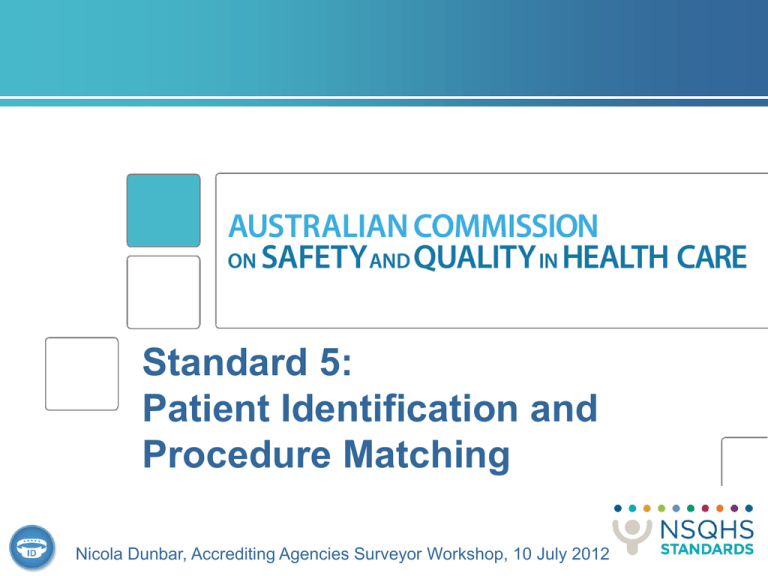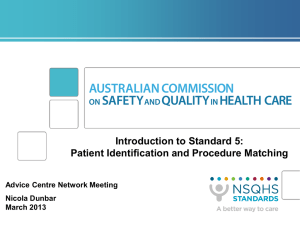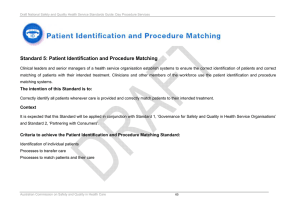PowerPoint 1.04 MB - Australian Commission on Safety and Quality
advertisement

Standard 5: Patient Identification and Procedure Matching Nicola Dunbar, Accrediting Agencies Surveyor Workshop, 10 July 2012 Why have a Standard about patient identification? Correctly identifying patients and matching them to their treatment is fundamental to safe care Risks occur when there is a mismatch between a given patient and components of their care – diagnostic, therapeutic, supportive Patient identification is such a routine process – can be seen as unimportant Putting systems in place to ensure patients are correctly matched to their care means that more attention can be paid to more complex tasks The Standard Clinical leaders and senior managers of a health service organisation establish systems to ensure the correct identification of a patients and correct matching of patients with their intended treatment. Clinicians and other members of the workforce use the patients identification and procedure matching system. Two overarching Standards: • Standard 1: Governance for Safety and Quality • Standard 2: Partnering with Consumers Three criteria 1. Identification of individual patients • 2. Processes to transfer care • 3. At least approved patients identifiers are used when providing care, therapy or services A patient’s identity is confirmed using three approved patient identifiers when transferring responsibility for care Processes to match patients to their care • Health service organisations have explicit processes to correctly match patients with their intended care 1. Identification of individual patients 5.1 Developing, implementing and regularly reviewing the effectiveness of a patient identification system including the associated policies, procedures and/or protocols that: • define approved patient identifiers • require at least three approved patient identifiers on registration and admission • require at least three approved patient identifiers when care therapy or other services are provided • require at least three approved patient identifiers whenever clinical handover, patient transfer or discharge documentation is generated Why? • Systematic approach is needed to ensure resources and procedures are organised, integrated, regulated and administered to achieve objective of correctly identifying patients 1. Identification of individual patients What? • Develop or confirm organisation-wide system for patient identification and describe key requirements for monitoring effectiveness • Agree on strategies for evaluating the patient identification system • Identify where responsibility sits for the patient identification system • Use data from the monitoring system to guide improvements 1. Identification of individual patients Issues • What is an “organisation-wide patient identification system”? • a system of explicit policies, procedures and protocols that apply across the organisation and cover: • consistent and correct identification of patients • matching identity using at least three identifiers • should include processes for patient identification: • at admission or registration • when matching a patient’s identity to care, therapy or services • whenever clinical handover, patient transfer or discharge documentation is generated • in specific service settings if they are different from those generally used across the organisation 1. Identification of individual patients Issues • What are “approved patient identifiers”? • • • • • • patient name (family and given names) date of birth gender address medical record number Individual Healthcare Identifier • room and bed number should not be used as they are frequently changed and not intrinsically linked to an individual 1. Identification of individual patients Issues • Documentation could include: • policy framework and governance (5.1.1): • policies and procedures regarding patient identification and matching of patients to their care that apply across the organisation • policies and procedures for specific clinical areas (eg outpatients) • identification of where responsibility for patient identification sits within the governance framework, eg terms of reference, position descriptions, committee papers etc • evaluation of performance (5.1.1): • plans and audit schedules regarding evaluation and audit of performance of patient identification and procedure matching policies • reports of audits, reviews and evaluation of compliance with and performance of patient identification system • taking action to improve performance (5.1.2): • examples of improvement activities • education and training records 1. Identification of individual patients 5.2 Implementing a robust organisation-wide system of reporting, investigation and change management to respond to any patient care mismatching events Why? • Although efforts to eliminate mismatching events have been in place for some time, these types of patient safety incidents continue to occur • When these incidents occur they can provide useful information about how systems can be improved What? • Establish / confirm incident reporting system that captures data on patient mismatching events and near misses • Use information from the incident reporting system to improve performance 1. Identification of individual patients Issues • Incident reporting system included in this criterion should be part of the broader system required as part of Criterion 1.14 • Actions to improve performance relevant here and for 5.1 1. Identification of individual patients 5.3 Ensuring that when a patient identification band is used, it meets the national specifications for patient identification bands Why? • Specifications for standard patient identification bands are evidence-based and were endorsed by Australian Health Ministers in 2008 What? • Introduce / confirm that the identification bands used in your organisation meet the national specifications 1. Identification of individual patients Issues • Specifications for standard patient identification band relate to: • • • • • • • colour size comfort usability method for recording patient identifiers information presentation new technology 1. Identification of individual patients Issues • Most implementation issues have related to: • colour of the band: • recommend one white band only • if considered necessary to have a coloured alert band – should be red only • information included on the band: • core patient identifiers only – name, date of birth, medical record number • Identification bands may not be needed for all parts of the health service eg outpatients, mental health • these areas should still be included as part of the organisation-wide patient identification system required as part of 5.1 • Documentation: • bands that comply with the specifications • policies / components of policies that include identification bands (5.1) 2. Processes to transfer care 5.4 Developing, implementing and regularly reviewing the effectiveness of the patient identification and matching system at patient handover, transfer and discharge Why? • There are significant patient safety risks at transitions of care • Ensuring the identity of the patient is maintained during the transition will reduce this risk What? • Introduce / confirm structures handover, transfer and discharge processes that include the use of three patient identifiers for each patient 2. Processes to transfer care Issues • Patient identification and use of three identifiers should be included in structured clinical handover system introduced as part of Standard 6 • Documentation will be based on policies, procedures and protocols required for Standard 6: • need to ensure that these include patient identification and use of three identifiers 3. Processes to match patients and their care 5.5 Developing and implementing a documented process to match patients to their intended procedure, treatment or investigation and implementing the consistent national guidelines for patient procedure matching protocol or other relevant protocols Why? • The use of protocols and checklists provide patient safety benefits • These tools can be effectively applied to patient identification processes What? • Develop / adapt and implement protocols for matching patients to their intended treatment • Monitor compliance with protocols and take action to improve performance 3. Processes to match patients and their care Issues • Protocols for matching patients and their care: • Ensuring Correct Patient Correct Site Correct Procedure: • originally developed by Australian Council on Safety and Quality in Health Care and RACS (2004) • jurisdictional / regional / hospital policies based on original protocol • additional protocols developed for specific areas outside surgery (2008) – radiology, nuclear medicine, radiation therapy, oral surgery • WHO Surgical Safety Checklist: • adapted by RACS use in Australia • includes patient identification • key steps: • • • • • marking site (if necessary) verification of identity verification of procedure / site etc time out confirmation of all documentation post-procedure 3. Processes to match patients to their care Issues • Processes to match patient to their care should be included in organisation-wide patient identification system • Evaluation and improvement processes should be linked to overarching system (see 5.1) • Documentation: • protocols / templates for matching patients to their care • may have specific protocols for specific clinical areas (such as surgery, radiology etc) • policies / components of policies that include processes for matching patients to their care (see 5.1) Resources Safety and Quality Improvement Guide for Standard 5 Specifications for standard patient identification bands – and FAQs and fact sheets Patient and procedure matching protocols Jurisdictional policies and protocols Summary Patient identification is a basic clinical process and needs to be done properly to ensure safety Purpose of the Standard is to improve outcomes for patients by setting out basic requirements for patient identification processes Standard based on a systems approach – rather than what is often ad hoc








